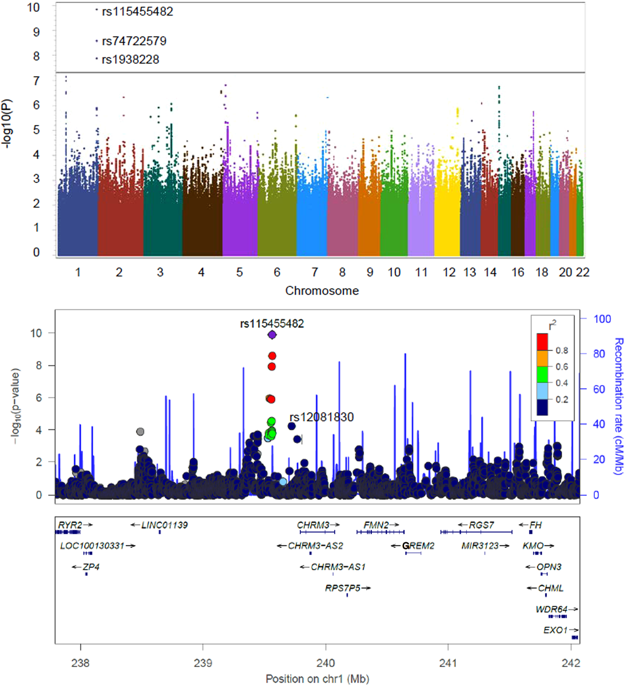当前位置:
X-MOL 学术
›
Transl. Psychiaty
›
论文详情
Our official English website, www.x-mol.net, welcomes your
feedback! (Note: you will need to create a separate account there.)
A regulatory variant of CHRM3 is associated with cannabis-induced hallucinations in European Americans.
Translational Psychiatry ( IF 5.8 ) Pub Date : 2019-11-18 , DOI: 10.1038/s41398-019-0639-7 Zhongshan Cheng 1 , Chureerat Phokaew 1 , Yi-Ling Chou 2 , Dongbing Lai 3 , Jacquelyn L Meyers 4 , Arpana Agrawal 2 , Lindsay A Farrer 5 , Henry R Kranzler 6 , Joel Gelernter 1, 7
Translational Psychiatry ( IF 5.8 ) Pub Date : 2019-11-18 , DOI: 10.1038/s41398-019-0639-7 Zhongshan Cheng 1 , Chureerat Phokaew 1 , Yi-Ling Chou 2 , Dongbing Lai 3 , Jacquelyn L Meyers 4 , Arpana Agrawal 2 , Lindsay A Farrer 5 , Henry R Kranzler 6 , Joel Gelernter 1, 7
Affiliation

|
Cannabis, the most widely used illicit drug, can induce hallucinations. Our understanding of the biology of cannabis-induced hallucinations (Ca-HL) is limited. We used the Semi-Structured Assessment for Drug Dependence and Alcoholism (SSADDA) to identify cannabis-induced hallucinations (Ca-HL) among long-term cannabis users (used cannabis ≥1 year and ≥100 times). A genome-wide association study (GWAS) was conducted by analyzing European Americans (EAs) and African Americans (AAs) in Yale-Penn 1 and 2 cohorts individually, then meta-analyzing the two cohorts within population. In the meta-analysis of Yale-Penn EAs (n = 1917), one genome-wide significant (GWS) signal emerged at the CHRM3 locus, represented by rs115455482 (P = 1.66 × 10-10), rs74722579 (P = 2.81 × 10-9), and rs1938228 (P = 1.57 × 10-8); signals were GWS in Yale-Penn 1 EAs (n = 1092) and nominally significant in Yale-Penn 2 EAs (n = 825). Two SNPs, rs115455482 and rs74722579, were available from the Collaborative Study on the Genetics of Alcoholism data (COGA; 3630 long-term cannabis users). The signals did not replicate, but when meta-analyzing Yale-Penn and COGA EAs, the two SNPs' association signals were increased (meta-P-values 1.32 × 10-10 and 2.60 × 10-9, respectively; n = 4291). There were no significant findings in AAs, but in the AA meta-analysis (n = 3624), nominal significance was seen for rs74722579. The rs115455482*T risk allele was associated with lower CHRM3 expression in the thalamus. CHRM3 was co-expressed with three psychosis risk genes (GABAG2, CHRNA4, and HRH3) in the thalamus and other human brain tissues and mouse GABAergic neurons. This work provides strong evidence for the association of CHRM3 with Ca-HL and provides insight into the potential involvement of thalamus for this trait.
中文翻译:

CHRM3的调节变体与欧洲裔美国人的大麻诱导的幻觉有关。
大麻是使用最广泛的非法药物,可引起幻觉。我们对大麻诱发的幻觉(Ca-HL)生物学的理解是有限的。我们使用药物依赖性和酒精中毒半结构评估(SSADDA)来确定长期使用大麻的人(使用过的大麻≥1年和≥100次)中的大麻诱发的幻觉(Ca-HL)。全基因组关联研究(GWAS)是通过分别分析Yale-Penn 1和2队列中的欧洲裔美国人(EA)和非裔美国人(AA),然后对人群中的两个队列进行荟萃分析而进行的。在Yale-Penn EA(n = 1917)的荟萃分析中,在CHRM3基因座处出现了一个全基因组显着(GWS)信号,由rs115455482(P = 1.66×10-10),rs74722579(P = 2.81× 10-9)和rs1938228(P = 1.57×10-8);在Yale-Penn 1 EA中(n = 1092),信号为GWS;在Yale-Penn 2 EA中,名义上显着(n = 825)。酒精中毒遗传学数据的合作研究(COGA; 3630长期大麻使用者)可以得到两个SNP,即rs115455482和rs74722579。信号没有复制,但是当进行元分析Yale-Penn和COGA EA时,两个SNP的关联信号增加了(元P值分别为1.32×10-10和2.60×10-9; n = 4291) 。在AA中没有显着发现,但在AA荟萃分析(n = 3624)中,rs74722579的标称意义显着。rs115455482 * T风险等位基因与丘脑中较低的CHRM3表达相关。CHRM3与丘脑,其他人脑组织和小鼠GABA能神经元中的三种精神病风险基因(GABAG2,CHRNA4和HRH3)共表达。
更新日期:2019-11-18
中文翻译:

CHRM3的调节变体与欧洲裔美国人的大麻诱导的幻觉有关。
大麻是使用最广泛的非法药物,可引起幻觉。我们对大麻诱发的幻觉(Ca-HL)生物学的理解是有限的。我们使用药物依赖性和酒精中毒半结构评估(SSADDA)来确定长期使用大麻的人(使用过的大麻≥1年和≥100次)中的大麻诱发的幻觉(Ca-HL)。全基因组关联研究(GWAS)是通过分别分析Yale-Penn 1和2队列中的欧洲裔美国人(EA)和非裔美国人(AA),然后对人群中的两个队列进行荟萃分析而进行的。在Yale-Penn EA(n = 1917)的荟萃分析中,在CHRM3基因座处出现了一个全基因组显着(GWS)信号,由rs115455482(P = 1.66×10-10),rs74722579(P = 2.81× 10-9)和rs1938228(P = 1.57×10-8);在Yale-Penn 1 EA中(n = 1092),信号为GWS;在Yale-Penn 2 EA中,名义上显着(n = 825)。酒精中毒遗传学数据的合作研究(COGA; 3630长期大麻使用者)可以得到两个SNP,即rs115455482和rs74722579。信号没有复制,但是当进行元分析Yale-Penn和COGA EA时,两个SNP的关联信号增加了(元P值分别为1.32×10-10和2.60×10-9; n = 4291) 。在AA中没有显着发现,但在AA荟萃分析(n = 3624)中,rs74722579的标称意义显着。rs115455482 * T风险等位基因与丘脑中较低的CHRM3表达相关。CHRM3与丘脑,其他人脑组织和小鼠GABA能神经元中的三种精神病风险基因(GABAG2,CHRNA4和HRH3)共表达。











































 京公网安备 11010802027423号
京公网安备 11010802027423号